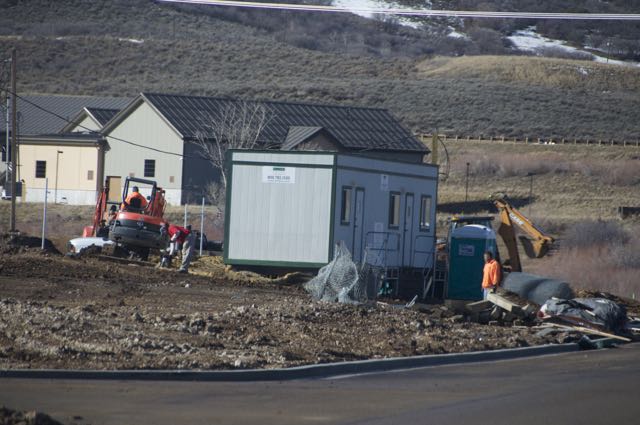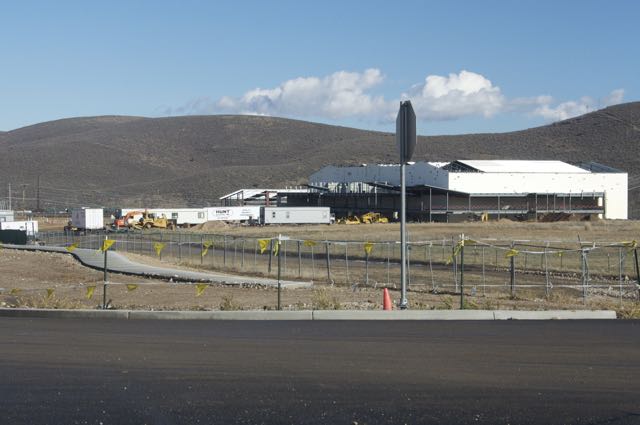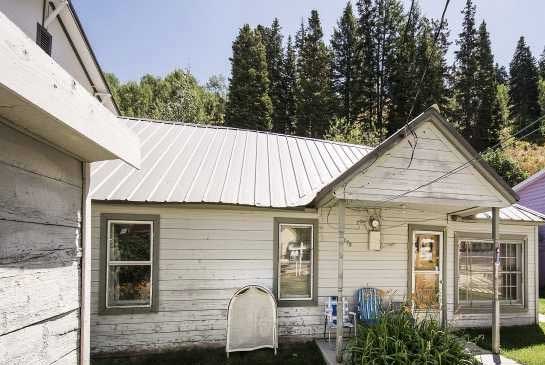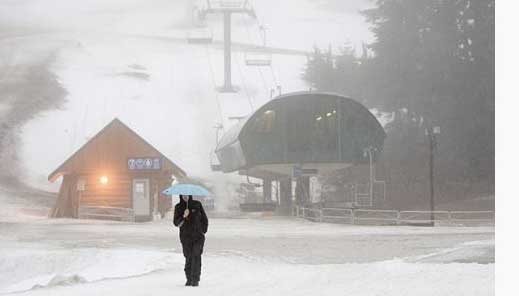Where is the Promised Construction at the Film Studio?
We were driving down 248 today and noticed there was no construction happening at the Film Studio. We took a left turn and headed down to Park City Heights. It was like Santa’s village with construction folks doing all sorts of things. We thought, “this is what it looks like when someone really wants to finish their project.”

It got us thinking back to October when a press release was issued that said the cessation of work allowed the Park City Film Studios to complete an agreement with NewPark developer Gary Crandall to help continue development. It also said, “General Contractor, Sahara, L.LC., confirms that it was asked to advance the project forward and felt it prudent to get paving down ‘so we could continue to push on through the winter. Upon completion of the paving we anticipate commencing construction at the prior pace barring any inclement weather.”
We remember that week after construction resumed, dump trucks were seen moving everywhere onsite. We saw some graters and backhoes working too. PROGRESS! Yet, a couple weeks later we heard comments from people saying they only ever saw one or two pieces of equipment running out there.
Now, we are into December… it’s 46 degrees outside and we see nothing. The last few weeks should be a blessing for construction but we don’t see asphalt laid (perhaps it is in someplace we can’t see from outside). We don’t see much construction going on. We can still see straight through the building. There appear to be holes in roof.
So, is construction continuing? Has substantial progress been made? Will the studio be ready to open in the spring? Granted we don’t camp at Quinn’s so maybe we’ve missed it all.
It just seems really strange. Park City Heights gives the appearance of action — a desire and will to complete something. Park City Film Studios looks like it is … well… in limbo.
It doesn’t bode well.

When you walk up Park Avenue What Do You Think?
On Thursday, the Park City City Council is going to discuss whether to provide Park City historic homes with up to $25,000 in matching grants for renovations. This got us to thinking about those historical homes. Here is an example of what we think of when we think of those homes:
Yes they are historic. Yet, they aren’t very different from the run-down row homes you may see in Maryland, Chicago, or New Jersey. Are they worth updating? Does run-down fit the image Park City wants? Will fixing some siding help?
What may seem quaint to one person may seem third world to another.
If you had a choice, would you use your tax dollars to fix up some of the hundreds of run down houses in Park City or would you allow something “better” to be built”?
The rain. What Does it mean for our growth?
If you follow city and county government, you KNOW that the population of our area is GOING TO INCREASE by over a 100% in the next few years. We’ll go from 35,000 people to 80,000. Therefore we must plan for the future by limiting traffic, building light rail, and having plenty of quick serve restaurants to meet the demand.
Yet, isn’t this year interesting? We had an early snow that allowed PCMR to open by Thanksgiving, but, if we are honest, we’d call our early season warm and rainy. Many people would say it’s an anomaly. For now it may be. However, if you read the studies on global warming, our winter season is going to get even shorter. Our summer season is going to be hotter and drier. This early winter is likely a cautionary tale for what is coming.
If you delve into specific studies like the one PCMR did in 2009, you’ll find that in 15 years “projected decreases in snowpack will have severe economic consequences for the region. By 2030, the estimated decrease in snowpack is estimated to result in $120.0 million in lost output. This lost output is estimated to result in an estimated 1,137 lost jobs and $20.4 million in the form of lost earnings (or labor income).” To put that in perspective, $120 million is 50% more than the entire impact of Sundance as calculated by the University of Utah.
So, if fewer people come to ski during the season (in 2030 the season is probably from January to March) in Park City, fewer people will likely live here.
What does it all mean? We really don’t know. That’s above our pay grade. However, we do note the inconsistency with those that both believe global warming is happening and that our population is going to explode. If global warming is happening (which we would say is the scientific bet), and summers are hot and winters rainy, we’d guess the trend of influx into our little town will slow. Given that, our 30 year plans should probably look a lot different from they do now.
A Perspective on Challenges Facing the School System
We received a great comment last week from what appears to be a member of the Park City School system (because we are an open platform we don’t require proof). While we of course don’t agree with everything the commenter says, we do find them thought provoking. We think the comment is worth reprinting here to ensure as many people see it as possible:
It is certainly correct that the district goal is to reduce some of the course options at PCHS but this is generally to provide more structured course guidance to our student body and not driven by cost. Less classes taught will result in more sections of other classes as the number of students is not going down. The result, a narrower set of course options but not a lower budget.
Currently, many elective classes are taught or not taught based on the number of students registered for the class. So, if no one registers for Accounting, it is not taught. Is accounting a class we should encourage our students to take? Perhaps bookkeeping is a good career option with flexible family-friendly hours. The decision makers tasked with addressing our course selections are wise. They have all the facts and we, the tax payers, pay them to make these decisions. To assume we, who see things from the outside and do not have all the facts should be making these choices is rather egotistical. Would we welcome educators to come into our businesses or homes and tell us how they should be run? Of course not. They do not know the nuances of our world. Throughout the annual school district budgeting process there are hundreds of factors parents simply are not aware of. I encourage all parents to be certain they have the facts before voicing opinions. Asking questions is the best place to start. As I tell the PCCAPS students, “Always travel with the facts or you may make a fool of yourself.”
Interestingly, there are studies that show at the high school level a large class size is not necessarily a bad thing. Of course, it depends on the type of class but 92% of PCHS seniors state they are heading off to college and these same students will be sitting in lecture halls of 300+ in college. Getting some practice with a class of 150 in the high school lecture hall might be a good idea and would potentially reduce kindergarten class sizes which is a district-wide need.
What about online course options? Students are taking classes online on the side. Unfortunately, the completion rate for those courses is fairly low. Why not offer online courses with teacher support and guidance at the high school? This could be great use for the underutilized library and allow students to work at their own pace. Online courses have been shown to be effective in reducing expenses in districts around the country. and for parents and students, online classes offer options. My 8th grade daughter has one period or parent release because she is taking World History online. She also took Health online so she would have an extra elective option available to her, which is the Digital Media / Photoshop class. My 11th grade son attends the Winter Sports School and, while it was the right choice for him, I am sorry he is missing out on the amazing course selection at PCHS. Pre-Engineering, PCCAPS, Advanced Drawing, Economics, Statistics, Theater…….
I do not know if the over 300 students who take parent release cost the district money by not being in class but if a student is not in the school he is missing out on a free education. Sure some of our students take parent release for athletics or to take online college courses, etc. but most of the parent release students who could be taking Economics, Psychology, Statistics, Creative Writing, Music, Art, Theater, programming or Entrepreneurship courses are sleeping in instead.
One of the key factors we must all consider when reducing course selection at the high school is, “what will help our students succeed in life?” AP Classes stretch our academic students’ minds, PCCAPS gives all students a glimpse at and practice in the professional world. Fine Arts classes help expand their creativity and History courses give them much needed perspective beyond their own experiences. I do not envy those who will have to make the tough decisions about course offerings in our high school but I do know there is much more to those decisions than meets the eye.
The Power of the Corporation
Last week, Vail announced they were donating $1.3 million in community grants to 30 non-profit organizations in Summit and Wasatch Counties. These monies will go to organizations like the Peace House, Recycle Utah, and Summit Land Conservancy. You really can’t argue with it or the fact that they doubled the amount versus the previous year. It’s “Free Money” that will benefit our community in so many ways.
A week earlier, Park City residents came together for Live PC Give PC. $1 million was raised for local charities. This was a huge increase over the $800,000 raised the year before.
All combined this is over $2.3 in money and time given back to our community. That is great!
However, we are struck by the power of the corporation. Live PC Give PC is a huge community endeavor; it’s like the whole town raises up and its life force is propelled into giving. There is power in that. Yet it appears there is more power in a corporation writing a check. With the wave of the pen Vail can assign $1.3 million of it’s $37 million dollar profit where it likes. Perhaps we’re jaded by this Vail Business Journal Article about Epic Promise which says, “Employees will have completed [projects] to commemorate Vail Resorts’ newly launched EpicPromise, a branding platform designed to engage resort guests and residents of the communities where is operates in one of the company’s core values, Do Good.” So Live PC Give PC is about charities and EpicPromise is about a … branding platform.
It’s like comparing two kids… one who buys baseball card packs hoping to find the player he loves in one of those packs and the other who’s dad buys the whole year’s set of cards. They’ll probably both eventually get the player’s card they wanted, but one way just seems better than the other.
We don’t know what the alternative is and would we really want to turn down money for non-profits? It’s tough.
Do we harbor any ill will toward Vail? I guess not. Does the whole giving thing seem more like just a transaction. Yes.
Welcome to the new normal.
Look for more posts soon
Due to our personal issue last Friday, we haven’t posted recently. We should be back up and going in the next couple of days. Thanks for the understanding.
We Were Robbed and Here is What We Wish We Would Have Known
On Friday someone broke into our house and stole a number of items. It sucks, but we thought we’d at least try to make lemonade out lemons. So, we wanted to share what we wish we would have known before it happened, in case it can help someone else:
- We were robbed when I went to pick up the kids from daycare at 4:30PM on Friday, so it can happen any time
- The house was empty for less than 45 minutes, so it can happen fast
- In our case, the burglar pounded on a basement window to break the locking mechanism and climbed through into the basement. We should have had something in the window tracks to prevent the window from opening.
- It appears the burglar went straight to the bedrooms and started going through drawers looking for jewelry. We should have either had it locked up or put in some random place. We’ve since read that an average break-in takes 8 minutes… so whatever you do to make it harder and more time consuming is good.
- The thief took laptops and ipads he found along the way. The serial numbers on these are your best shot of catching him when he tries to sell them. Make sure you have them.
- The thief stole a hand gun. It was in a locked case and out of the way. So, thieves are smart. I didn’t keep track of the serial number. I should have so that law enforcement would have a record.
- I was in such a panic when I found out, that I missed obvious things like that the thief left a clipboard in my bedroom. Try to slow dow and take it all in so you can provide all info to law enforcement.
- If people are walking around your neighborhood and it seems strange, call your security company or law enforcement. It never hurts to be safe. If the person is on the up and up, then a visit with security shouldn’t be a problem.
- Touch as little as you can. The thief may or may not wear gloves. If not, being careful may preserve a fingerprint.
- The sheriff’s deputy who came to assist had just worked a fatal motorcycle accident. He was remarkably composed. These men and women have a tough job.
- Anything you really don’t want stolen should be in a safe deposit box. We got off relatively lucky… but it was sheer luck. We’ll pay $60 a year for a box on Monday.
Anyhow, we hope this helps someone else avoid our fate. Having two dogs, we thought something like this would never happen. We were wrong.
Does Five Guys Have the Best Customer Service of Any Restaurant in Park City?
You may know Five Guys. It’s the quick-serve burger joint in Kimball Junction that arrived as park of the area’s latest expansion. They are known for their statement that there isn’t a freezer in the place (i.e. nothing is frozen before you eat it). Yet, that’s not the surprising thing. What surprises us most is that it may have the best customer service of any restaurant in or around Park City.
We know what you are thinking, there is no way a hamburger business could have better service than all the Food-and-Wine-Magazine restaurants on Main Street. We’re not so sure. When you walk into Five Guys you’ll usually hear them say something like “3” customers in the door. Before you get to the counter, they’ll greet you with a smile and ask how you are doing. Once we asked back, “How are you?”. The guy taking our order pointed at the mountains out the windows and said ” how could I be bad with that view?” They take your order, make sure it is right, and provide you your number. When they bring out your food, it’s in a brown paper bag typically with the top folded impeccably to prevent heat from escaping. We’ve eaten at Five Guys at least a dozen times, with pretty complicated orders, and have never had a mistake with the order. The experience is frankly shocking, when you realize these people aren’t making tips and probably not much more than minimum wage.
That’s not to say we haven’t had great experiences at places like Riverhorse and Wahso on Main Street. They stand up equally in terms of customer service. Yet of the restaurants we’ve tried on Main (and we’ve been to most), only a few equal the customer service at the little burger joint in Kimball.
We do get it. Finding good help for a Top 100 Wine Spectator Magazine restaurant is tough. Yet, somehow a chain hamburger restaurant is besting most of the best that Park City has to offer.
Is it Our Community’s Responsibility to Ensure Availability of Housing for Seasonal Workers?
Each year about this time we read about seasonal workers struggling to find places to stay around Park City. This problem then gets muddled with affordable and workforce housing. The conclusion is typically that the citizens of Park City need to figure this out…or else. Case in point is the ending sentence from this year’s Park Record article on the topic. “If the ski season pans out as predicted,workforce housing will be back at the top of the agenda in a serious way and Park City’s future success will depend on how effectively it is addressed.”
While we don’t doubt that temporary workers have a tough time finding places to stay, it doesn’t seem that cut and dry. However, first let’s cut to the chase on what affordable and workforce housing traditionally means. Typically the terms workforce and affordable housing are used interchangeably and mean rental units and homes that people can afford whose salary is between 60% and 120% of Area Medium Income (AMI). AMI for a family in Park City is 70,602. So, in this case workforce housing is targeted at families with incomes from 40,000 to 84,000. A temporary worker, coming to Park City for the winter likely doesn’t fit into this range. That doesn’t mean that they don’t suffer from an issue, it’s just not really a traditional “affordable housing” problem. Affordable housing initiatives seem targeted at those people who live here year round and always need a place to stay (i.e. it’s not just a winter issue). But that’s another topic entirely.
So, we have people who come to Park City to work during the winter and need a place to stay for 4 months. In years gone by, we could see how it would seem like a local issue. Deer Valley, PCMR, and Canyons (ParkWest or Wolf Mountain in way earlier times) felt local and we needed to support out local. That’s not the case anymore. Today’s Park City is really Deer Vally and Vail. Deer Valley makes multi, multi millions per year, enough so that they bought Solitude. Vail had revenues of $1.3 billion in 2013. Do cities like Anaheim and Orlando concern themselves with housing for Disney workers? Not really. If anything they push Disney to figure it out. The same should happen here. If those company’s want the best workers, they’ll figure out a way to make sure they get them and they’ll take care of this issue along the way.
There are, of course, others that come to Park City during the season to work restaurants, ski shops, and other ancillary jobs outside the resorts. While the numbers pale in comparison, we’re not sure that’s really our responsibility either. The city and county get sales tax revenue from these businesses, and that benefits the community. However, the people who own the businesses are the people who monetarily succeed based on their employees. Again, it seems like perhaps the businesses should work together to figure this out.
So, we hear about the problem every year but each year we get a little more numb to it. Our sympathy we feel for the worker slowly shifts to disbelief toward the corporations.Yet, every year that we make it out to be a city, county, or community problem is one more year that the businesses don’t have to fix the issue.
So the question we ask is, “Is this really our community’s problem or does the answer lie with the businesses that profit?” We have our opinion but we expect come November 2015, we’ll hear all about this again.
On 2-for-1’s Dinners Don’t Pay the Extra Sales Tax
Park City Restaurants are winding down their 2-for-1 offers but we recently learned a way to save a little cash. It seems that most Park City restaurants include the tip, for what would have been the total price, on the bill of most 2-for-1’s. It’s much like when you have a party of 6 or more and the tip is already on the bill when you get it. The restaurant is afraid you’ll stiff the wait staff by not tipping for the “real” value of the meal.
However, this costs you money. That’s because any tip that is included on the bill by the restaurant is subject to sales tax per Utah tax law. So, save yourself the sales tax and tell your server you’ll tip on the “real” amount and see if they will let you hand write your tip. That way you don’t get charged the extra tax. It’s likely only a few bucks, but why not keep it if you can.



